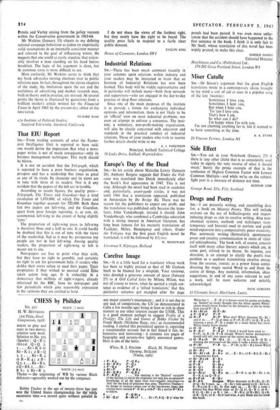CHESS by Philidor
No. 32o.
H. W. BETTMANN (1st Prize, Good Companions, 1918)
WHITS to play and mate in two moves; solution next week. Solution to No. 319 (Sparke) : Q - B 5, threat Q-Q 3. t...Kt-K6or Kt-K 2; 2 B -Q 3. . . . Kt - K 4 or B-K4; 2B- Q5. ... Kt - B 5,
2 Q - B 8. x . ICt - Theme — the unpinning of WB by various Black defences—agreeably worked out by the composer.
Bobby Fischer at the age of twenty-three has just won the United States championship for the- tenth successive time — a record quite without pa`ial el in BLACK (7 men)
any major country's tournament ; and it is not due to any lack of competition, the US (as demonstrated in Cuba a few months ago) being at least as rich in chess masters as any other country except the USSR. This is a good moment perhaps to suggest Profile of a Prodigy: The Life and Games of Bobby Fischer by Frank Brady (Nicholas Kaye, 2Is.) as recommended reading. I started this prejudiced against it, expecting a sensationalist account but in fact found it fair, in- formative and interesting : it contains too pages of biography and seventy-five lightly annotated games. Here is one of the latter.
White, R. J. FISCHER Black, M. NAJDORF Opening, SICILIAN (Varna, 1962)
P - K9 P- B4
a Kt-KB3 P-ts3 3 P - Q_4 PxP
4 Kt x P Kt-KB3 5 Kt-QB3 P-QR3
6 P - K Rs ..The The opening is the 'Najdorf' variation of the Sicilian in which the originator not only has an extensive knowledge of all the main lines but—equally important—a 'fed' for the kind of positions that arise. Therefore Fischer— by design or instinct—plays one of theless-known lima; this curious move intends P - K Kt 4 with PL Kt l and/or /V- Kt 2 to follow. 6... P - Q Kt 4 7 KS— Q 31 B - tat 7 . . Kt x P; tt Q - B 3! wins for
White but 7 ... P - K 3! is better—now his pawns are broker up. Najdorf no doubt thought that his threat against White': centre would throw Fischer on the defensive, or else he woulc have played P - K 3.
8 Kt x Kt ch Kt P x Kt
9 P - Q 134! PxP so B x P B x P What else? White threatens Q_- Kt = and if ro ... P- Q It thai it PxP, B xP?.; za Q-R 4 cli winning a piece. P - K 3 might be a shade better but leave! White clearly betterilaced.
rr 0 - 0
P- 4 ra R - K sl P - 4? I think I would have tried 12 . . . B x P; 13 K x B, P x El though White's better development should still tell; text opens up the centre too much. 13 Q.- R 4 eh Kt - Q a 13 . . . Q - Q 2; 14 B - Q Kt winning the exchange—all the same it looks a better chance. 14 R x BI P x R x4 ...P xB; is Kt - B 5 leaves Whit in command.
15 Kt-BS 8 - 8 4 r6 Kt - Kt 7 eh K - K a 16 ... K - B r; i7B - R 6,K - Kt i is hopeless for Black
17 Kt-B5 eh K-K r r8 13 - K 3 BxB
19 PxB Q - 1C13
so R -is
R-Rs
u R- 6
— Q I 22 Q— t 3,3— B 2 22 . . . R - B I; 23 Kt—Kt 7 ch, K -K 2; 24 Q-11 3!
s3 BxP eh K - Q r
24 B- K 6 Resigns. White threatens 25 B x Kt,Q x B; 26 Q - Kt 8 mate. 24 ... Q - Kt r fails against 25 Q - Kt 6 ch, R - 18 2;46 B x Kt. At first sight 24 . . . R - Kt a looks • defence but then White MAY* 25 Q - Q 5I, Q - B I. 36 R B 61,fil- Kt z or R x (26 ... R -B a; 27B xKtl, QxB; 28 R - 6); 27 R - Kt 6! and wins. A pity Black did not allow this •






























 Previous page
Previous page